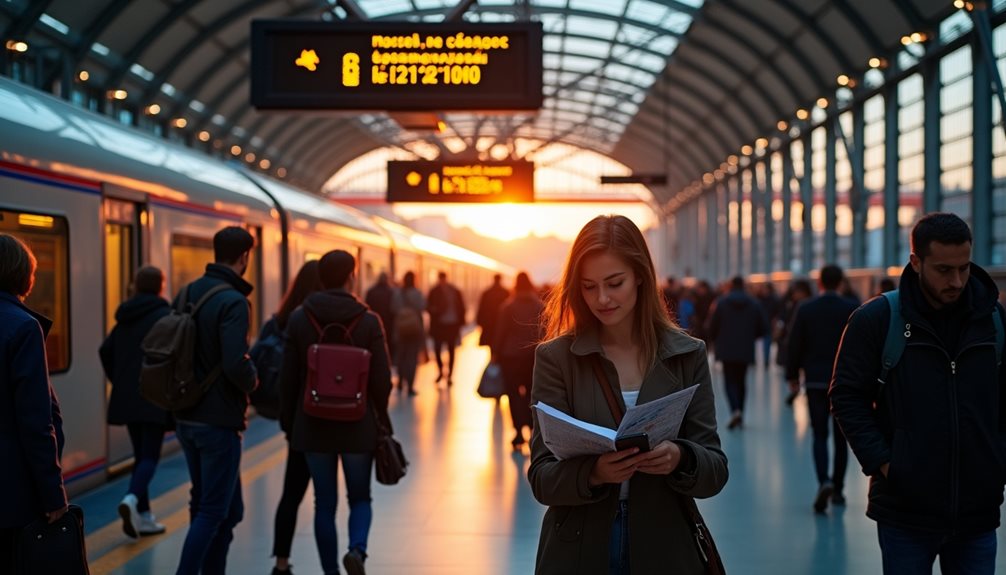Mastering directions and transportation terms in Russian is the key for travelers to unlock the breathtaking beauty and rich culture of Russia’s vast landscapes. Whether wandering the bustling streets of Moscow or exploring the serene countryside, knowing essential vocabulary transforms the travel experience from confusing to confident. With a handful of useful phrases, travelers can connect with locals, navigate public transport like pros, and understand road signs effortlessly. Embracing these skills not only makes the journey smoother but also opens the door to authentic encounters and unforgettable adventures in this incredible country. Travelers can get ready to explore Russia with ease and excitement!
Table of Contents
ToggleBasic Russian Vocabulary for Transportation

Traveling across Russia offers a fascinating adventure, but to fully enjoy it, understanding basic transportation vocabulary is very helpful. Russia is enormous, spanning 11 time zones, so getting around requires knowing how to use various forms of transport and the right words to navigate them.
One of the most iconic ways to travel in Russia is by train. The country’s railway system is one of the largest and busiest in the world, with famous routes like the Trans-Siberian Railway that stretches from Moscow all the way to Vladivostok. Train stations in Russia are often grand and historic buildings, where you might hear announcements or see signs with words like “вокзал” (vokzal) meaning “train station,” “платформа” (platforma) meaning “platform,” and “билет” (bilet) meaning “ticket.” When buying a ticket, phrases like “Я хочу купить билет” (Ya khochu kupit’ bilet) — “I want to buy a ticket” — can be very useful.
In addition to trains, buses are a common way to travel within cities and between towns. Russian buses vary from large city buses (“автобус” – avtobus) to smaller minibuses called “маршрутка” (marshrutka), which often follow fixed routes. Bus stops are marked with “остановка” (ostanovka). Knowing how to ask “Где остановка автобуса?” (Gde ostanovka avtobusa?) means “Where is the bus stop?” This helps when waiting for public transport.
In many Russian cities, especially Moscow and Saint Petersburg, the metro system is a very popular and efficient way to travel. The Russian word for metro is “метро” (metro). Metro stations are known for their beautiful designs and clean operations. Signs will indicate lines like “линия” (liniya), which means “line.” For example, “красная линия” means “red line.” To ask where the metro entrance is, you can say: “Где вход в метро?” (Gde vkhod v metro?) — “Where is the metro entrance?”
For those traveling by car or taxi, knowing words like “такси” (taksi) for taxi and “машина” (mashina) for car is helpful. Ride-hailing apps are common in Russian cities, but if you need to hail a taxi on the street, simply saying “Такси, пожалуйста!” (Taksi, pozhaluysta!) means “Taxi, please!”
With these essential vocabulary tools, one can confidently initiate an unforgettable journey through Russia’s vibrant mosaic of culture and history.
Key Phrases for Asking Directions
Navigating the streets of a foreign city can be both exciting and challenging. For travelers exploring Russia or any Russian-speaking area, knowing key phrases for asking directions is essential. These phrases not only help you find your way but also make it easier to connect with locals, who often provide valuable tips beyond what maps show. Understanding and using these expressions can turn a confusing journey into a smooth and enjoyable experience.
Essential Phrases for Asking Directions
One of the most common questions to ask when you’re lost or looking for a place is:
- “Где находится…?” (Gde nakhoditsya…?) — Where is…?
Use this phrase to ask where a specific location is. For example, “Где находится вокзал?” means “Where is the train station?”
Another useful phrase is:
- “Как добраться до…?” (Kak dobrat’sya do…?) — How do I get to…?
This asks for instructions on how to reach a place. For example, “Как добраться до метро?” means “How do I get to the metro?”
When you don’t understand what someone says, you can politely say:
- “Я не понимаю.” (Ya ne ponimayu.) — I don’t understand.
This phrase helps you ask for repetition or clarification, which is very useful when speaking with native speakers.
Transportation Vocabulary
Knowing transportation-related words will help you ask good questions and understand directions better. Here are some important ones with pronunciation guides and meanings:
- вокзал (vokzal) — train station
- платформа (platforma) — platform (where you wait for a train or bus)
- билет (bilet) — ticket
- поезд (poyezd) — train
- автобус (avtobus) — bus
- маршрутка (marshrutka) — minibus or fixed-route taxi — a very common, affordable way to travel short distances in Russian cities
- остановка (ostanovka) — bus stop
- метро (metro) — metro or subway
- линия (liniya) — line (used for metro or bus routes, e.g., “красная линия” means “red line”)
- такси (taksi) — taxi
- машина (mashina) — car
- бензин (benzin) — gasoline or fuel
Useful Questions About Transportation
To get more specific information, you can use these questions:
- “Сколько стоит билет?” (Skol’ko stoit bilet?) — How much does a ticket cost?
This is important if you want to know the price before buying. - “Во сколько отправляется поезд?” (Vo skol’ko otpravlyayetsya poyezd?) — What time does the train leave?
Useful for checking departure times. - “Где находится автобусная остановка?” (Gde nakhoditsya avtobusnaya ostanovka?) — Where is the bus stop?
Helps you find where to catch the bus.
Tips for Asking Directions in Russia
- Russians often appreciate when foreigners try to speak their language, even if only a few words. It shows respect and can encourage locals to help more willingly.
- When asking for directions, it helps to show the name of your destination written down in Russian. This is especially useful because place names can be hard to pronounce.
- Use gestures like pointing on a map or showing your phone screen with the address.
- Remember that public transport in large Russian cities like Moscow and St. Petersburg is extensive and reliable but can be confusing for newcomers without some knowledge of key terms.
- Metro systems usually have color-coded lines called “линии” (linii), which makes it easier to follow directions.
Mastering simple phrases like “Где находится…?”, “Как добраться до…?”, and knowing key transportation words will greatly improve your ability to travel independently in Russia. These tools help you communicate your needs clearly and understand responses more easily, making your journey safer and more enjoyable.
By combining verbal questions with visual aids such as maps, you can explore Russian cities confidently and discover not just famous landmarks but also hidden spots recommended by locals. This approach enriches your travel experience by building stronger connections with people and the culture around you.
![]()
Navigating Public Transport in Russia
When visiting Russia, understanding how to use public transport is very important. Cities like Moscow and Saint Petersburg have large, busy systems that include buses, trams, and a metro (subway). Learning some basic Russian words and phrases related to public transport will make your travel easier and more comfortable.
Important Tips for Using Public Transport in Russia
- Plan Your Route Beforehand
Russian cities often have complex transport maps. Use apps or websites to check routes and schedules. Knowing the names of stops and lines in Russian helps a lot. - Buy Tickets in Advance
Usually, you buy tickets before boarding. Ticket offices or machines are at metro stations. Sometimes you pay a fixed fare; other times, it depends on distance. Always keep your ticket until you leave the system to avoid fines. - Respect Public Transport Etiquette
- Give up your seat to elderly people, pregnant women, or disabled passengers.
- Keep noise low; avoid loud conversations and phone calls inside vehicles.
- Don’t eat or drink on public transportation; it’s considered rude.
- Boarding and Exiting
Let passengers exit first before you enter. Doors typically open automatically but sometimes need a button press.
Common Russian Terms for Public Transport
| Cyrillic | English Phonetic | English Definition |
|---|---|---|
| автобус | avtobus | bus |
| трамвай | tramvay | tram (streetcar) |
| метро | metro | metro (subway) |
| билет | bilet | ticket |
| остановка | ostanovka | stop |
| маршрут | marshrut | route |
| водитель | voditel’ | driver |
| пассажир | passazhir | passenger |
| вход | vkhod | entrance / entry |
| выход | vykhod | exit |
| старший пассажир | starshiy passazhir | senior passenger (elderly) |
| инвалид | invalid | disabled person |
| сиденье | siden’ye | seat |
| платить | platit’ | to pay |
| оплата | oplata | payment |
| проездной билет | proyezhnoy bilet | travel pass / transit card |
Example Phrases Useful for Travelers
- Где купить билет?
Gde kupit’ bilet? – Where can I buy a ticket? - Сколько стоит проезд?
Skol’ko stoit proyezd? – How much does the fare cost? - Это автобус до центра?
Eto avtobus do tsentra? – Is this the bus to the city center? - Можно пройти, пожалуйста?
Mozhno proyti, pozhaluysta? – May I pass, please? - Это место свободно?
Eto mesto svobodno? – Is this seat free?
Knowing these words and phrases will help you feel more confident while using public transport in Russia. Remember to observe local customs like giving up seats and keeping noise down for a respectful and smooth experience.
Essential Terms for Taxis and Ride-Sharing
When traveling in Russia, knowing key terms related to taxis and ride-sharing can make your experience smoother and more comfortable. Whether you choose a traditional taxi or use a ride-sharing app, being familiar with the right vocabulary helps you communicate clearly and avoid confusion.
Taxi Hailing and Booking
The phrase “вызов такси” (pronounced: vyzov taksi) means “calling a taxi.” This is commonly used when you want to order a cab by phone or through an app. Another useful phrase is “заказать такси” (zakazat’ taksi), which means “to order a taxi.” Many Russians use popular apps like Яндекс.Такси (Yandex.Taxi) or Gett, where you place a “заказ” (zakaz) – an order or booking – for your ride.
When speaking directly to a driver or dispatcher, you can say:
- “Мне нужно на адрес…” (Mne nuzhno na adres…) – “I need to go to the address…”
- “Вы можете меня забрать здесь?” (Vy mozhete menya zabrat’ zdes’?) – “Can you pick me up here?”
Ride-Sharing Terms
Ride-sharing services have become widespread in Russia’s major cities. The word “поездка” (poezdka) means “trip” or “ride.” Once your order is confirmed, you’ll often see the details of your поездка in the app, including estimated cost and driver information.
Understanding fare-related terms is helpful:
- “Тариф” (tarif) – tariff or rate/fare
- “Минимальный заказ” (minimal’nyy zakaz) – minimum order amount, sometimes applied during busy hours
- “Цена за километр” (tsena za kilometr) – price per kilometer
Payment Methods
Russian taxi and ride-sharing services offer various payment options. You can pay with “наличные” (nalichnye) – cash, or “картой” (kartoy) – by card. Most apps accept bank cards and sometimes digital wallets like Apple Pay or Google Pay. It’s useful to clarify the payment method beforehand by asking:
- “Можно оплатить картой?” (Mozhno oplatit’ kartoy?) – Can I pay by card?
- “У вас есть сдача?” (U vas yest’ sdacha?) – Do you have change? (important if paying cash)
Other Useful Phrases
- “Сколько будет стоить поездка?” (Skol’ko budet stoit’ poezdka?) – How much will the trip cost?
- “Подождите, пожалуйста” (Podozhdite, pozhaluysta) – Please wait
- “Остановите здесь” (Ostanovite zdes’) – Stop here
- “Я опаздываю” (Ya opazdyvayu) – I am running late
Tips for Travelers
- In Russia, it’s common to confirm your destination verbally even if you ordered via an app. This avoids misunderstandings, especially in cities with similar street names.
- Always check the car’s license plate and driver’s name before entering to ensure it matches the app details for safety.
- If hailing a taxi on the street, look for cars with a “такси” sign on the roof or a company logo on the door.
- During peak times, fares may increase due to demand; ride-sharing apps usually notify you of surge pricing in advance.
By mastering these terms and phrases, travelers can navigate the bustling streets of Russian cities confidently, communicate effectively with drivers, and enjoy hassle-free transportation throughout their journey.
Understanding Road Signs and Directions in Russian
Navigating the streets of Russia requires more than just knowing how to hail a taxi or use a ride-sharing app. A key part of getting around safely and confidently is understanding the road signs and directions used throughout the country. This knowledge helps travelers avoid confusion, follow traffic rules, and enjoy their journeys without unnecessary stress.
Common Russian Road Signs and Their Meanings
Here are some essential road signs you should recognize when driving or walking in Russia:
- Stop Sign (Стоп)
A red octagon with the word “Стоп” written in white. It means you must come to a complete stop before proceeding. - One Way (Одностороннее движение)
Indicates that traffic flows only in one direction on that road. Look for signs with arrows showing the permitted direction. - Pedestrian Crossing (Пешеходный переход)
This sign alerts drivers to slow down and yield to pedestrians crossing the street. It usually features a person walking within a zebra crossing pattern. - Speed Limit (Ограничение скорости)
Displays the maximum speed allowed on that stretch of road, typically shown within a red circle with numbers.
Additional Useful Road Signs and Terms
To help you get a broader understanding, here are more road signs and related terms that you might encounter:
- Yield (Уступи дорогу) – This sign tells drivers to give way to other vehicles.
- No Entry (Въезд запрещен) – Indicates that entry to a particular street or area is prohibited.
- Traffic Light (Светофор) – Signals to stop or go using red, yellow, and green lights.
- Roundabout (Круговое движение) – Indicates a circular intersection where traffic moves counterclockwise.
- Parking (Парковка) – Shows designated parking areas.
Related Russian Terms Table
| Cyrillic | Phonetic | English Definition |
|---|---|---|
| Стоп | Stop | Stop sign |
| Одностороннее движение | Odnostoronnye dvizheniye | One-way traffic |
| Пешеходный переход | Peshekhodny perekhod | Pedestrian crossing |
| Ограничение скорости | Ogranichenie skorosti | Speed limit |
| Уступи дорогу | Ustupi dorogu | Yield |
| Въезд запрещен | V’ezd zapreshchyon | No entry |
| Светофор | Svetofor | Traffic light |
| Круговое движение | Krugovoye dvizheniye | Roundabout |
| Парковка | Parkovka | Parking |
Mastering these terms will help you read signs more quickly and understand directions given by locals or found on maps.
Example Scenario
Imagine you’re driving in Moscow and see a blue sign with a white arrow pointing right, labeled “Одностороннее движение.” This means the street only allows traffic in that direction, so turning left would be illegal. Right after, you see a “Пешеходный переход” sign. You should slow down and watch out for people crossing the street.
Knowing these signs and terms prepares you to maneuver safely and confidently through Russian cities and towns.
Understanding these symbols empowers travelers, allowing them to navigate with confidence and enjoy the freedom of exploration in Russia’s urban landscapes.
Frequently Asked Questions
How Do I Use a Russian Metro Map Effectively?
Maneuvering a Russian metro map effectively requires understanding metro map symbols and engaging in thorough route planning. Familiarity with lines, transfer stations, and connections empowers travelers, offering them a sense of freedom and confidence in their journeys.
What Payment Methods Are Accepted for Public Transport in Russia?
In Russia, public transport payment methods include cash payments and digital wallets. Travelers can enjoy convenience and flexibility, choosing between traditional currency or modern technology, enhancing their journey through this vibrant country while maintaining freedom of choice.
Are There Any Travel Apps Recommended for Navigating Russian Transport?
Travel apps play an essential role in steering Russian transport systems. Users find valuable navigation tips within these applications, enhancing their travel experiences and enabling them to explore the vast country with confidence and ease.
How to Ask for Help if I’m Lost in Russia?
When lost in Russia, one might approach locals, using simple lost phrases like “Где я?” (Where am I?). Engaging kindly, they often offer guidance, revealing a path toward newfound freedom and exploration amidst unfamiliar surroundings.



